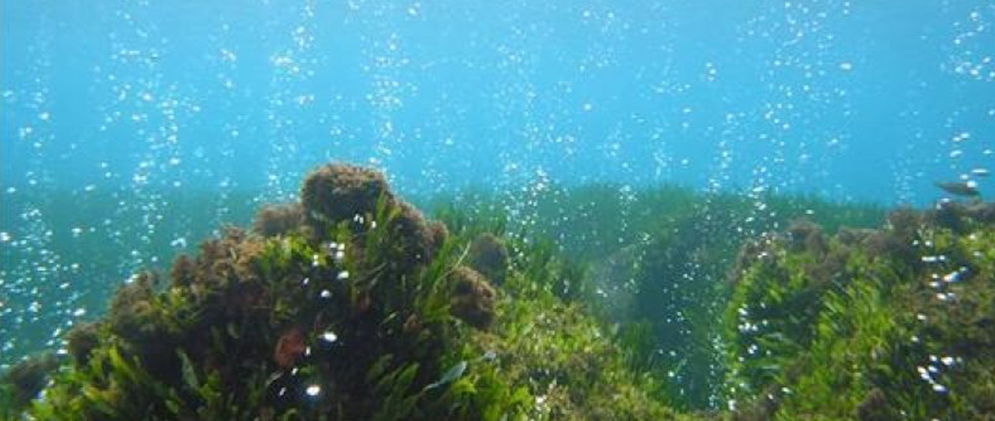Assessing Learning in a Virtual Reality Field Trip
From The Theme
DIGITAL LEARNING ENVIRONMENTS
WHAT IF
What if we could use the unique affordances of VR to enhance the classroom experience?

WHAT WE SET OUT TO DO
Our goal was to explore how Virtual Reality Field Trips can enable new learning, with a specific focus on ocean acidification. We created a 15-minute “Virtual Reality (VR) Field Trip” that enabled users to move through a coral reef below the ocean’s surface. This mixed methods research project leveraged qualitative methods to understand how VR can be used in a classroom, as well as quantitative data mining tools to uncover new connections between the rich data afforded by immersive VR and other, more established learning metrics.
WHAT WE FOUND
The VR Field Trip enabled users to experience ocean acidification. Users became a pink coral among the dark purple sea urchins, sea bream and sea snails. By the end of the simulation – which fast-forwards to what the reef will look like at the end of this century – those brilliantly varied and colorful species have disappeared and been replaced by slimy green algae and the silver Salema Porgy fish – a species that will likely thrive in the higher acidity. Eventually, the user’s coral skeleton disintegrates and disappears; the rocky reef ecosystem has been destroyed. “If ocean acidification continues, ecosystems like your rocky reef, a world that was once full of biological diversity, will become a world of weeds,” the narrator says.
The results of the pilot study are preliminary, but powerful. Subjects in the virtual reality group demonstrated more empathy for the environment than those who watched a movie about acidification. When surveyed a week later, a change of attitude endured only for those in the virtual reality group.
LEARN MORE
The Stanford Ocean Acidification Experience
Stanford VHIL Lab Sustainable Behaviors Projects
SF Gate – Virtual Reality Could Make a Real Difference in Environment
PEOPLE BEHIND THE PROJECT
 Roy Pea is the David Jacks Professor of Learning Sciences and Education, Graduate School of Education. Since 1981, Dr. Pea has been exploring how information technologies can support and advance the scientific understanding and practices of learning and teaching, with particular focus on topics in science, mathematics, and technology education and their associated symbolic and communicative interchanges that are integral to learning.
Roy Pea is the David Jacks Professor of Learning Sciences and Education, Graduate School of Education. Since 1981, Dr. Pea has been exploring how information technologies can support and advance the scientific understanding and practices of learning and teaching, with particular focus on topics in science, mathematics, and technology education and their associated symbolic and communicative interchanges that are integral to learning.
 Fiorenza Micheli is a Professor of Biological Sciences, David & Lucile Packard Professor in Marine Sciences. Fiorenza’s research focuses on the processes and interactions shaping coastal marine communities and incorporating this understanding in the management and conservation of marine ecosystems. She is most interested in how disturbance and interactions between species underlie the organization, spatial variation, and temporal change in marine communities.
Fiorenza Micheli is a Professor of Biological Sciences, David & Lucile Packard Professor in Marine Sciences. Fiorenza’s research focuses on the processes and interactions shaping coastal marine communities and incorporating this understanding in the management and conservation of marine ecosystems. She is most interested in how disturbance and interactions between species underlie the organization, spatial variation, and temporal change in marine communities.
 Jeremy Bailenson is founding director of Stanford University’s Virtual Human Interaction Lab, the Thomas More Storke Professor in the Department of Communication at Stanford, and a Senior Fellow at the Woods Institute for the Environment. He designs and studies virtual reality systems that allow physically remote individuals to meet in virtual space, and explores the manner in which these systems change the nature of verbal and nonverbal interaction. In particular, he explores how virtual reality can change the way people think about education, environmental behavior, and health.
Jeremy Bailenson is founding director of Stanford University’s Virtual Human Interaction Lab, the Thomas More Storke Professor in the Department of Communication at Stanford, and a Senior Fellow at the Woods Institute for the Environment. He designs and studies virtual reality systems that allow physically remote individuals to meet in virtual space, and explores the manner in which these systems change the nature of verbal and nonverbal interaction. In particular, he explores how virtual reality can change the way people think about education, environmental behavior, and health.